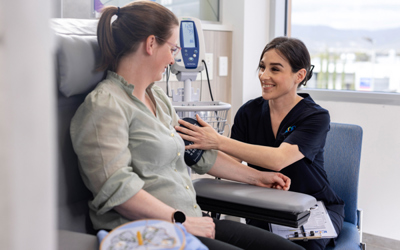What is myelodysplasia?
Myelodysplasia, also known as Myelodysplastic Syndrome (MDS), includes a collection of diseases (sometimes referred to as a group of cancers) which affect the growth and development of healthy blood cells in your bone marrow.
In the past myelodysplasia was called “pre-leukaemia” as in some cases the disease transforms to Acute Myeloid Leukaemia (AML), although this does not always occur.
The malignant cell in myelodysplasia is a myeloid stem cell. Such bone marrow stem cells are cells that can develop into any type of blood cell (i.e. they are responsible for making red blood cells, white blood cells and platelets).
Risk factors for myelodysplasia
In the vast majority of cases it is not known why someone develops myelodysplasia, with the exact cause of the disorder not fully understood. However, gene mutations (abnormal change in the DNA sequence) that occur during a person’s lifespan play a role in the development of the disease.
Other factors that are thought to increase the risk of MDS developing include:
Exposure to certain chemicals such as benzenes and petroleum-based products
Having had chemotherapy or radiation treatment
People with certain congenital conditions such as Down’s Syndrome or Fanconi anaemia have an increased risk.
Diagnosis of myelodysplasia
Myelodysplasia is generally suspected based on abnormal blood tests and confirmed by a bone marrow examination.
Sub-typing of myelodysplasia
The World Health Organisation defines certain sub-types of MDS based on the following information from blood tests and bone marrow examination:
Percentage of blast cells in the bone marrow – Blast cells are immature cells which are usually only found in the bone marrow but can be found in the blood with diseases such as MDS or leukaemia
Chromosomal changes (Cytogenetics) – A test performed on bone marrow cells collected at a bone marrow examination
Ring sideroblasts – Cells seen on a bone marrow examination
Dysplasia – Blood cells that show abnormalities under the microscope
Number of cytopenias (low blood cell counts) – This information is gained from blood tests.
Types of myelodysplasia
The common types of myelodysplasia include:
-
Refractory Anaemia (RA)
This type of MDS affects red blood cells.
-
Refractory anaemia with ringed sideroblasts (RARS)
This type of MDS is similar to RA, except the red blood cells contain iron ring deposits around the nucleus of the cell.
-
Refractory cytopenia with multilineage dysphasia (RCMD)
This involves two or more affected types of blood cells, with less than 5% of blast cells found in the bone marrow.
-
Refractory cytopenia with multilineage dysphasia and ringed sideroblasts (RCMDRS)
This type of MDS is similar to RCMD, except the red blood cells contain iron ring deposits around the nucleus of the cell.
-
MDS with del(5q) chromosome
This type of MDS affects the red bloods cells causing anaemia, however it is associated with good outcomes.
-
MDS with excess blasts
This type of MDS involves one or more affected blood cells. It is known as MDS-EB and RAEB (i.e. refractory anaemia with excess blasts).
Type 1 – Bone marrow consists of up to 9% of blast cells, with less than 5% found in the blood
Type 2 – Bone marrow and circulating blood consists of up to 19% blast cells.
-
Mixed Myelodysplastic/myeloproliferative neoplasms (MDS/MPN)
This is a group of blood diseases that aren’t specific to any of the above MDS types. MDS/MPN have both too few and too many blood cells produced in the bone marrow.
Signs and symptoms of myelodysplasia
In the early stages of the disease there are often few, if any symptoms and the diagnosis is suspected due to abnormal blood tests alone. However, as the disease progresses people can experience the following symptoms depending on the type and severity of MDS.
Symptoms related to white blood cell abnormalities include:

Increased susceptibility to infections, particularly chest infections. Other common infections include sinus, urinary tract and skin infections
Symptoms related to red blood cell abnormalities include:

Chronic fatigue and a feeling of weakness

Shortness of breath without exertion

Pale skin
Symptoms related to platelet abnormalities include:

Increased frequency of bruising and bleeding, especially from the gums and nose
Treatment for myelodysplasia
Treatment depends on the sub-type of MDS you have, age as well as your medical history and preferences for treatment. Some treatment options for MDS can include:
Chemotherapy – Uses specific drugs to target and destroy the blast cells found in your bone marrow
Stem cell transplant – Involves transplanting stem cells from a healthy donor, however this option is usually only suitable for a small number of younger patients with MDS
Watch and wait – Often this is an option early on in the disease, where patients have few symptoms. Regular check-ups and monitoring is recommended
Supportive therapy – These involve a series of treatment options (including transfusions) to help reduce symptoms such as treatments for low red and white blood cells and platelets
Imunomodulatory drugs – Uses specific drugs to help improve marrow function. This is very effective in the 5q- sub type of MDS
Clinical trials – This can be a way to access novel therapies not yet licensed for routine use




